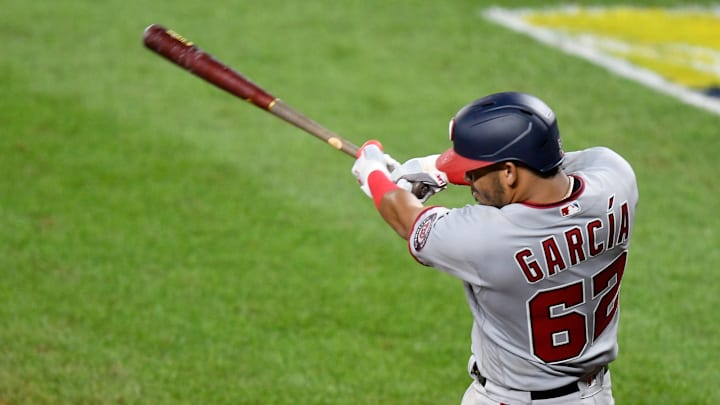Luis Garcia, leadoff guy? Yes, the same Luis Garcia who had a 2.9% walk percentage last year. It’s not as crazy as it sounds.
Conventional wisdom says that the leadoff man should be a high on-base percentage hitter who can hit for average and is a threat to steal a bag as soon as he gets on. Luis Garcia is not a high OBP guy and is not much of a threat to steal a bag.
Over the last couple of years, we have seen a shift in this thinking. We have seen teams move away from the conventional leadoff hitter and have begun hitting one of their second to fourth best hitters on the team in the leadoff spot.
The thought process behind this is teams have begun experimenting with putting a guy who can jump on a pitcher early and start a game off 1-0 or start with a nice double. Think of Kyle Schwarber, low batting average guy, not a high OBP guy was moved to leadoff for the Nationals, and it worked. He also was leading off for the Phillies during their run. The Yankees put Aaron Judge (AL MVP) in the leadoff spot and he does not fit the mold of the prototypical leadoff guy.
The Phillies aren’t the only NL East team who went with an unconventional leadoff hitter during a World Series run. The Braves had Eddie Rosario leadoff for much of their run and Rosario did not fit the mold of the prototypical leadoff hitter either. What he was good at however was being aggressive early in the count, catching a pitcher off guard and starting game off 1-0 or with a double.
In 2020, leadoff hitters walked (unintentionally) 9.22% of the time and hit a double 4.4% of the time (Garcia last year doubled 6.3% of the time). Leadoff hitters also had a wOBA of .327. A FanGraphs study of 1 million computer simulations found that teams with a leadoff hitter that was within .003 points of a wOBA of .327 (and just an average 2-9 hitters) scored on average half a run more per game.
Luis Garcia's wOBA is not .327, but it is projected to be much closer this year and his batting profile projects well at leadoff. Garcia averaged a 94.2 mph exit velocity on balls hit in the air last year. That places him in the 80th percentile of all hitters. We know Garcia is going to swing. He swings on 70% of the pitches in the Zone (MLB average is 66%), his first pitch swing % is 38.3 (MLB average is 29.5%), and his overall swing % is 52.5 (MLB average is 47.1).
Garcia has shown improvements offensively and flashed the pop. His barrel % is up 3% since he entered the league, his hard hit % is up 8% since he entered the league, and his sweet spot % is up 10% since he entered the league. With Garcia showing developments and improvements at the plate, his already impressive double % will continue to increase and the hard hit % increases will lead to more home runs as his exit velocity on balls hit in the air is a great indicator of more home run totals.
Garcia does have a high groundball rate at 51.3% which is a bit concerning. That number turns him into a BABIP-dependent singles hitter. Luckily, the shift has been eliminated and more of those ground balls should turn into hits. The Nationals have put an emphasis over the offseason on technological and analytical advancements and these advancements should help lower the ground ball rate and add more to his impressive exit velocity.
Garcia's batted ball profile shows good potential and growth as a hitter. His aggressiveness early into the count plays perfectly as a leadoff hitter. Leading off games pitchers are getting a feel for their pitches and are more likely to throw fastballs (10 run value against fastballs last season).
That run value plays nicely as 64% of first pitches thrown in MLB history have been a 4-seam or a 2-seam fastball. Garcia will also walk more this year simply based off the logic that he cannot possibly walk less than he did last season. That leads to great potential for Garcia to excel as the Nationals leadoff guy.
All statistics provided by FanGraphs.
